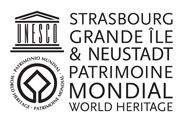- Discover
- Must-see attractions
- As you like it
- Strasbourg, capital of Christmas
- “Strasbourg mon amour”
- UNESCO
- Sustainable Tourism
- The french cycling capital
- Strasbourg and its surrounding area
- Excursions less than 2 hours away
- What to see and do
- Organising my stay
- 1-2-3 Days in Strasbourg
- Places to stay
- Places to eat
- Travelling to and around Strasbourg
- Brochures
- Strasbourg City Card
- Activities and incentives for groups
- Book a guided tour
-
Saint-Pierre-le-Jeune Catholic ChurchArchitecture
Built after the German annexation, this impressive church in pink sandstone features a stunning dome - the largest one in Alsace. Built from 1889 to 1893, it’s one of the finest architectural achievements of the Neustadt district.
Due to rapid population growth in the 19th century, especially after 1871, the Catholic congregation, which, up until that time, had been sharing the first Saint-Pierre-le-Jeune church with the Protestants, needed more room. Construction of the new church was assigned to the architects Skjold Neckelmann and August Hartel, who also designed the neighbouring courthouse and the university library.
In keeping with the eclectic architectural style of their time, they combined various designs harmoniously, borrowing from Romanesque architecture, such as Rhenish basilicas, and, for the floorplan and dome, from the Renaissance period, including St. Peter’s in Rome.
The church’s interior features impressive volumes. In the axis of the church, the main choir is elevated and surrounded by an ambulatory leading to the apse chapels.
The magnificent chandelier at the centre of the church bears witness to the skill of late 19th century silversmiths. It was crafted by Eugène Braun, and it symbolises New Jerusalem, with the twelve gates and twelve apostles.
The design and decoration of the pulpit make it one of the treasures of the church. Made by a sculptor from Colmar named Théophile Klem, it comprises a cylinder resting on six columns supported by lions. The angel, lions, capitals, human heads, door and Byzantine-style mosaics testify to the artistry of that time.
The main choir is dominated by a wide mosaic featuring panels representing several scenes from the life of Jesus.
To the right of the choir, the statue called “The Mystic Rose” is a masterpiece of finesse. It was sculpted by Henri Waderé, who was born in Colmar, and who was one of the best sculptors of his time. The Carrara marble statue delicately depicts the gracious curves of the body and the draping of the garment.
Like Saint Paul’s Church, which was built at the same time, the monumental architecture of Saint-Pierre-le-Jeune, and its integration into the urban landscape, make it a prestigious, structuring landmark for the city.
Type of place Religious sitePrice Free accessSchedule Daily from 9 a.m. to 6 p.m. (except during church services and ceremonies).Closing days : , Sunday morning -
Daily from 9 a.m. to 6 p.m. (except during church services and ceremonies).Closing days : , Sunday morning






